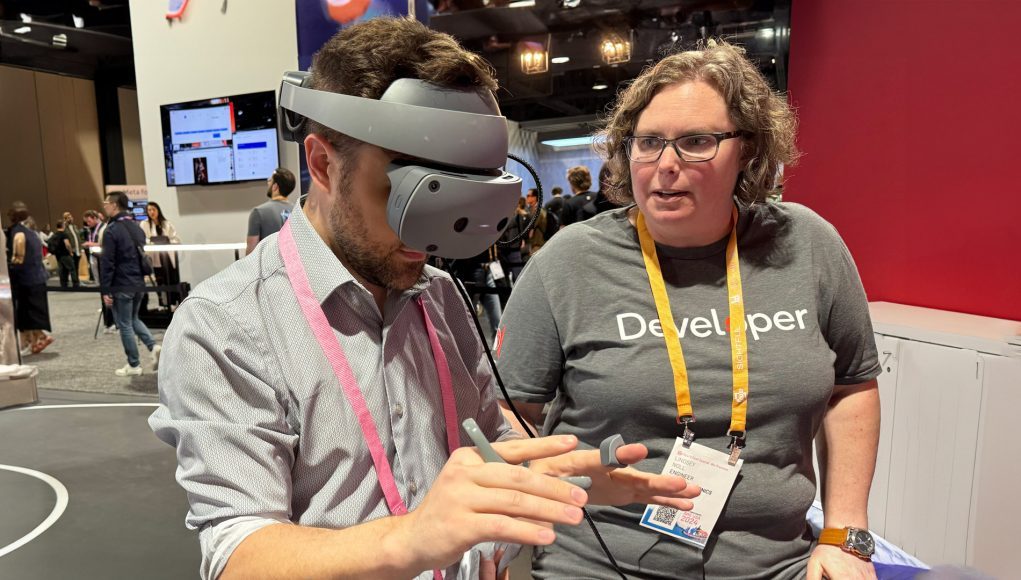Sony’s new headset, officially dubbed the SRH-S1 “content creation system” combines a compact form-factor with novel controllers. I got to check out the headset first-hand at AWE 2024 and came away impressed with the headset itself, even if the input and tracking still need some work.
The yet-to-be-priced Sony SRH-S1 is being designed as an enterprise headset. It’s built with Qualcomm’s latest Snapdragon XR2 Gen 2 processor for standalone usage. Sony also tells us it can be driven by a PC through a compressed video stream (like Quest Link).
Sony confirmed to Road to VR the headset’s actual resolution is 13.6MP (3,552 × 3840) per-eye, using Sony’s own ECX344A OLED microdisplay. The display is capable of 90 FPS and 1,000 nits (at 20% duty cycle), with 96% DCI-P3 color coverage. That means the Sony SRH-S1 with has higher resolution and better color accuracy than Vision Pro:
- Sony SRH-S1:
- 13.6MP per-eye
- 96% DCI-P3
- Apple Vision Pro
- 11.7MP per-eye
- 92% DCI-P3
The Sony MR headset also has compact lenses with a flip-up visor, and two utterly unique controllers: one is a star-shaped pointer, and the other is a ring that goes on your finger.
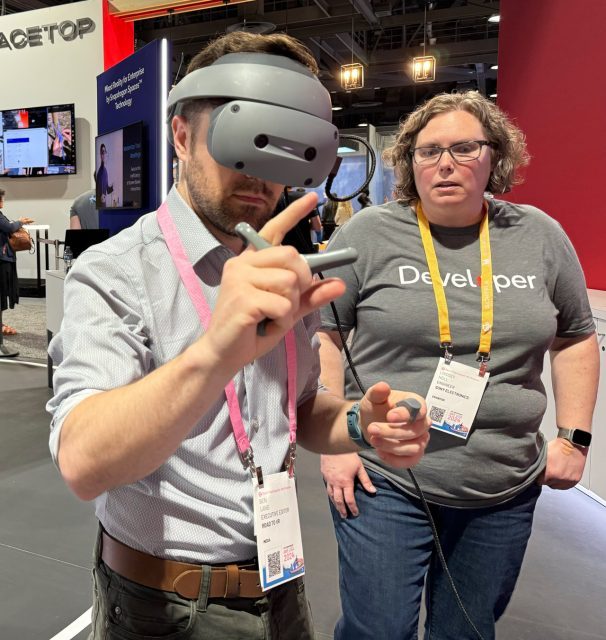
The SRH-S1’s ergonomic design is hits all the right notes. The headset has hardware-adjustable IPD, flip-up visor, rear-mounted battery for balance, and eye-relief adjustment. The eye-relief adjustment allows you to bring the lenses as close as possible to your eyes for the maximum field-of-view.
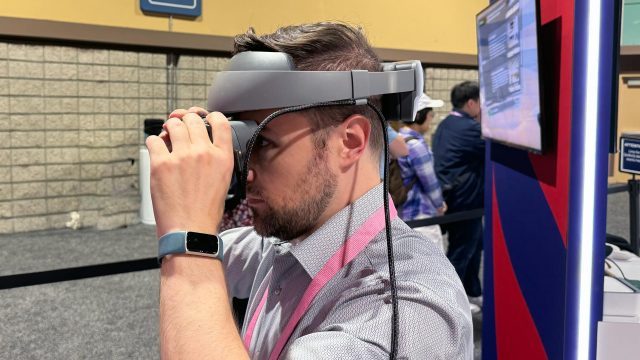
And though it’s all plastic, the headset and controllers feel well built, including the flip-up visor mechanism. Sony pitches the flip-up visor primarily so a user sitting at a connected computer can see the full resolution of their display, then flip down the visor when they’re ready to view virtual content.
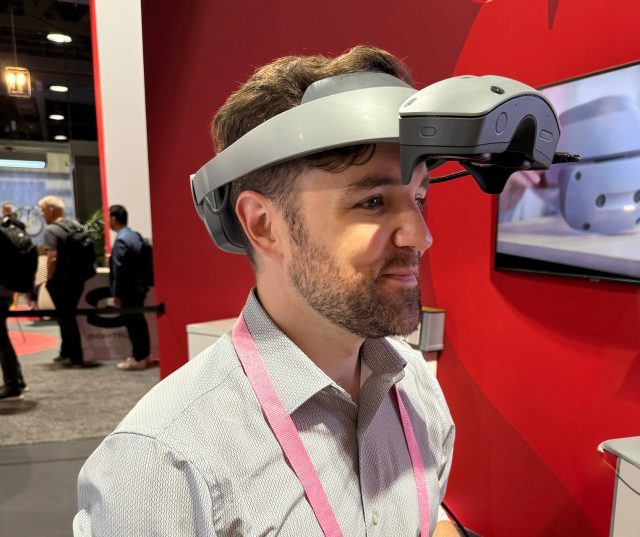
Granted, even with the eye-relief dialed all the way in, the field-of-view wasn’t expansive. It felt smaller than something like Quest 3, but not too small to be useful. A smaller field-of-view also means the headset’s pixels are even more densely packed, which—if the optics are up to the task—would mean notably sharper imagery than Quest 3 or Vision Pro.
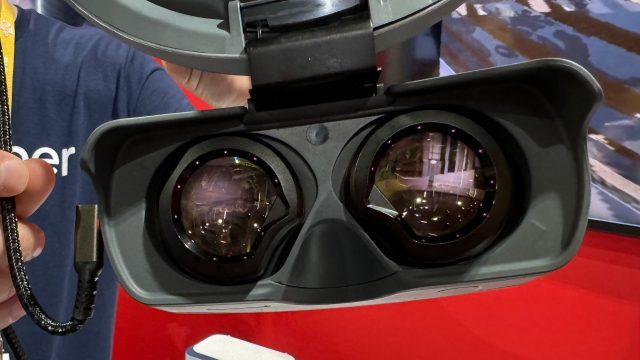
In my short time with the headset the display looked impressively sharp with absolutely no individual visible pixels. However, the content I saw wasn’t great for clearly comparing how the sharpness stacks up to contemporary headsets. I can say though that the optics appeared to have great edge-to-edge clarity, rivaling what I’m used to seeing with Quest 3’s excellent lenses.
I noticed some reflections in the lenses, though I’m fairly certain most of this was due to external light reaching the lenses from the headset’s open periphery. I didn’t get to try it but Sony has shown the headset with a soft peripheral blocker add-on for when you’d rather have less reflections and more immersion.
The demo seen I saw was a virtual filming setup where I was able to move and adjust a virtual camera that was shooting a virtual scene. I could also control the lighting by moving lights around and charging their colors.
While everything looked very sharp, the content being shown didn’t look well optimized for running on a standalone headset. That made the experience quite choppy—probably not running at a steady 90 FPS as it should—which made the head-tracking feel sub-par.
This probably impacted the feeling of the controller-tracking too, though I think the controllers had their own issues with latency and precision. The ring controller in particular had tons of jitter, making it quite bad for any kind of precision input—even just grabbing and moving things. The star-shaped controller felt much more precise, not just because the tracking was more steady, but also because you naturally hold it with an outstretched index finger, making it a natural ‘pointing device’. Even so it didn’t feel as precise as what you’d expect from a Quest 2 or Quest 3 controller.
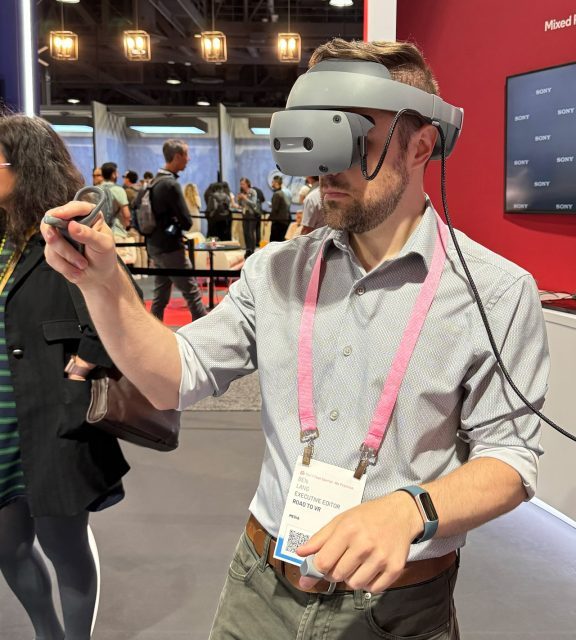
I quite like the concept of the SRH-S1 controllers, but they need some work still on more than just tracking. Both controllers actually have physical buttons on them which are elegantly hidden under the skin… which also makes it very unintuitive to know they even exist.
The rep showing me the headset was trying to describe the location of one of the buttons for me to press by saying something like “it’s on your index finger,” but they weren’t talking about the button under the tip of my finger. Instead, there’s another hidden button that you press with the inside of the first segment of your index finger (before you reach the first knuckle).
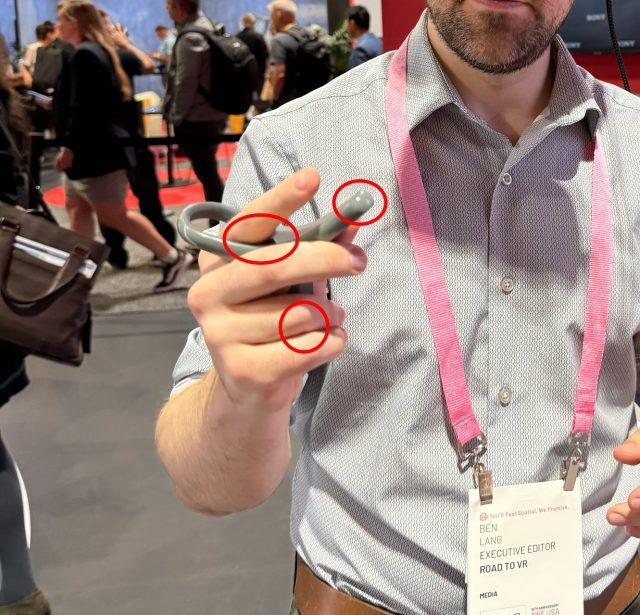
I literally don’t know if I’ve ever pressed a button using that part of my finger. So beyond being invisible, the fact that it’s in a weird place made it even more of an odd choice. It’s not necessarily a bad choice; this might be a great way to get two distinct inputs from one finger, given the unique controller design, but it needs to be much more intuitive.
And, indeed, it’s likely user experience details which will make or break the Sony’s SRH-S1 MR headset as a viable competitor to other headsets on the market. I feel fairly confident the company can get the device’s head and controller-tracking tightened up without any breakthroughs or major redesigns. But does Sony expect enterprise developers to figure out all the small details about how to teach users to use these unique controllers, and how to use them best in their applications?
Sony says the SRH-S1 is specifically made to work with Siemens NX, a comprehensive suite of CAD tools used by Sony itself. Presumably it will work with a wider range of software too, but presently it’s unclear what software platform or software standard the headset will support. Presumably OpenXR compatibility would be a good choice as an open standard, but even beyond that it’s not clear if Sony plans to maintain a software distribution platform for the headset or leave it up to companies to figure out how to deploy and manage the software.
Despite this being an MR headset, Sony unfortunately wasn’t ready to show the passthrough view, saying it was still being worked on.
Sony plans to launch the SRH-S1 headset later this year. But pricing, regional availability, and software compatibility haven’t been announced yet.

